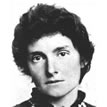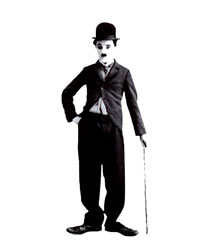A timeline history of Kennington with prints, photographs and maps. Click on images to enlarge.

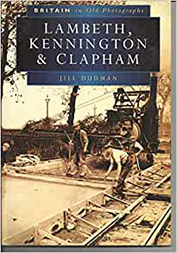
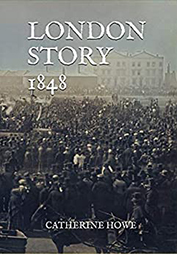
Battersea
Beckenham
Bermondsey
Bexley
Blackheath
Borough
Brixton
Brockley
Bromley
Camberwell
Catford
Charlton
Clapham
Croydon
Crystal Palace
Deptford
Dulwich Village
East Dulwich
Elephant and Castle
Eltham
Forest Hill
Greenwich
Herne Hill
Kennington
Lee
Lewisham
New Cross
Old Kent Road
Peckham
Rotherhithe
South Bank
Roman Kennington
c. 50 Roman Road (later known as State Street) ran from London Bridge to Chichester. Kennington Park Road follows its route.
Saxon Kennington
Kennington was originally in the county of Surrey.
The name comes from OE and may have meant 'farm or estate associated with Coena'.
Medieval Kennington
1086 Domesday mention of Chenintune
1229 Reference to Kenintone
1263 Reference to Kenyngton
1362 Kennington Palace built by Edward, the Black Prince (1330–1376). Commemorated by Black Prince Road.
Stuart Kennington
C17 James I settled manor of Kennington on Prince of Wales.
Charles I, when Prince of Wales, lived in a house on site of old Kennington Palace. He granted part of manor to Sir Noel Caron, ambassador to Holland. Caron built a mansion (demolished c. 1684). Part of mansion & grounds now form Oval Cricket Ground?
Georgian Kennington
1746 Scottish rebels hung at Surrey Gallows, Kennington Common.
1774 Kennington referred to as a village near Lambeth.
c.1775 Many Georgian terraces built including 140-162 Kennington Park Road.
c1787 309-341 Kennington Road built.
1789 Prince’s Square laid out (later Cleaver Square).
1790 114-132 Kennington Park Road by Michael Searles (1750-1813).
c1791 231-245 Kennington Lane built.
1818 Camberwell New Road built on part of Kennington Common.
1824 St Mark's Church built on site of old Surrey Gallows. Designed by David Riddall Roper (1774-1855) in the Classical style.

1825 Kennington Common enclosed.
1830 Print of Kennington Common by WH Prior (1812-1882).
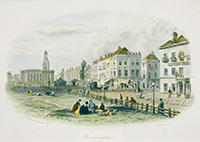
Early Victorian Kennington
1839 Walcot Square built.
1845 Cricket ground leased from Duchy of Cornwall at Oval. Surrey Cricket Club founded.
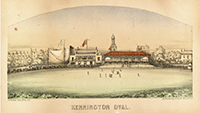
1847 Iron Gas holders installed next to The Oval Cricket ground,
1848 Chartists met at Kennington Common to campaign for electoral reform as they had been stopped from crossing the river to march to Downing Street.
Queen Victoria had left London for the Isle of Wight. The meeting dispersed in a peaceful manner.
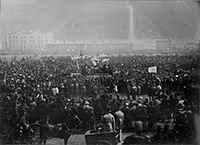
1854 Photo of Kennington Tollgate.

1854 Kennington Park opened.
1858 Edith Nesbit born at 38 Kennington Lane. Later wrote the Railway Children and others.
Mid Victorian Kennington
1860s Map of Kennington in much detail
1862 Map showing new Kennington Park. Prince’s Square shown (now Cleaver Square).
1865 Kennington Tollgate closed.
1870 Print of home-drawn tram passing St Marks Church
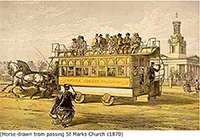
1873 New Lambeth Workhouse (by R Paris & Thomas W Aldwickle) opened. It replaced the old workhouse in Prince’s Street.
1877 Original Gas holder in Kennington Lane replaced. New one became the largest gas holder in the world.
St Agnes, Kennington Park, opened. Designed by George Gilbert Scott Jr. (1839-1897).
Late Victorian Kennington
1880 First test match against Australia at Oval.
1890s Charlie Chaplin lived at various addresses in Kennington including 3 Powell terrace, 39 Methely Street and Chester Street.
1890 Kennington Station opened on The City and South London railway (now Northern Line).
Oval Station opened on The City and South London railway (now Northern Line). Originally built with a dome.
1891 Oval Gas holders expanded by Sir Frank Livesey (1844-1899). Doubled capacity.
1896 Charlie Chaplin admitted to Lambeth Workhouse.
1898 Princess of Wales's Theatre (later Kennington Theatre) opened next to Kennington Park on the corner of Kennington Park Road and Kennington Park Place.
Designed by WGR Sprague (1863-1933).
Inter-War Kennington
1920s Oval station rebuilt minus dome.
1933 Newquay flats built on Sancroft Road by Louis de Soissons (1890-1962) for Duchy of Cornwall. Grade II listed.
1934 Jack Hobbs Gate installed at Oval.
Kennington Theatre closed.
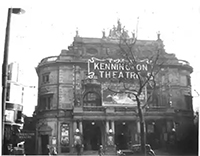
1937 Regal Cinema opened on the corner of Kennington Road and Black Prince Road. Designed by Bertie Crewe (1860-1937) and Henry J Kay (1893-1979).
Kennington in Second World War
1940 St Marks bombed and badly damaged.
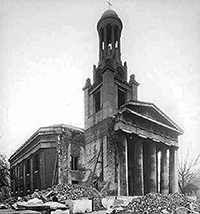
1941 St Agnes bombed and demolished
Post War Kennington
1948 Regal Cinema became a Granada Theatre.
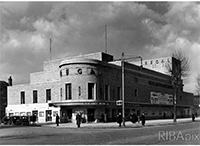
1949 Kennington Theatre demolished. Replaced by high rise flats.
1951 St Agnes church demolished.
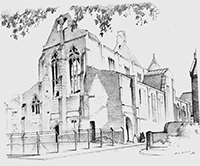
1958 New St Agnes Church, Kennington Park, opened. Designed by Ralph Covell (1911–1988).
1960 Restored St Mark’s opened.
1961 Granada Kennington closed. Became a Bingo Hall until 1997.
Book list
Cricket In Our Neighbourhood - History Of Kennington Oval - HH Montgomery (1885)
Lambeth Past - Hannah Renier (Historical Publications 1994)
Lambeth, Kennington & Clapham - Jill Dudman (1996)
Changing Faces of Kennington - Carole Newbigging (Robert Boyd 1999)
Kennington Park - The Birthplace of People's Democracy - Stefan Szczelkun (Past Tense 2005)
London Story 1848 - Catherine Howe (APS 2020


